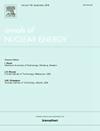IVMR modelling with transient effects during molten pool formation and stabilization – Outcomes from models’ comparison performed in the IAEA CRP J46002
IF 1.9
3区 工程技术
Q1 NUCLEAR SCIENCE & TECHNOLOGY
引用次数: 0
Abstract
In 2020, the International Atomic Energy Agency (IAEA) has started the 4-year Coordinated Research Project (CRP) on In-Vessel Melt Retention (IVMR) with the main objective to harmonize the international understanding of the scientific and technological bases underpinning crucial parts of the safety demonstration of this Severe Accident (SA) management strategy. This strategy consists in maintaining the degraded reactor core (corium) within the vessel by ensuring its cooling thanks to cavity flooding and power extraction through the vessel wall.
In the scope of this CRP, analytical benchmarks were performed focusing on different reactor designs. Among them, a generic 1000MWe PWR design benchmark was set up with a different objective compared to those dedicated to a given scenario and reactor. Its main purpose was to allow detailed comparison of models implemented in capable codes (either integral SA code or dedicated code) based on prescribed and simplified configurations. This paper presents the work done and achievements obtained within this benchmark. Different cases, corresponding to different corium configurations and boundary conditions, were developed with increasing complexity. In total, eight benchmarks are studied covering molten pool formation from solid particles, progressive corium relocation to the lower plenum, progressive molten steel incorporation, vessel wall ablation and possible stratification inversion. Together, they form an efficient and useful tool to better understand IVMR results and code capabilities or limitations. State of codes performance and remaining issues are discussed, focusing mainly on configurations involving progressive molten material arrival in the lower plenum.
在熔池形成和稳定过程中具有瞬态效应的IVMR模型——原子能机构CRP J46002中模型比较的结果
2020年,国际原子能机构(IAEA)启动了为期4年的容器内熔体保留(IVMR)协调研究项目(CRP),其主要目标是协调国际上对支撑这一严重事故(SA)管理战略安全论证关键部分的科学和技术基础的理解。该策略包括通过空腔注水和通过容器壁的动力提取来确保冷却,从而将降解的反应堆堆芯(堆芯)保持在容器内。在本CRP的范围内,对不同的反应器设计进行了分析基准测试。其中,通用1000MWe压水堆设计基准与专用于给定场景和反应堆的基准相比,目标不同。它的主要目的是允许在规定的和简化的配置的基础上,对可用代码(整体SA代码或专用代码)中实现的模型进行详细的比较。本文介绍了在此基准下所做的工作和取得的成果。不同的情况,对应不同的堆芯结构和边界条件,越来越复杂。总共研究了8个基准,包括固体颗粒形成熔池、堆芯逐步移至下层静压室、钢液逐步掺入、容器壁烧蚀和可能的分层反转。它们共同构成了一种有效而有用的工具,可以更好地理解IVMR结果和代码功能或限制。讨论了规范状态、性能和剩余问题,主要集中在涉及熔融材料逐步到达下层全会体的配置上。
本文章由计算机程序翻译,如有差异,请以英文原文为准。
求助全文
约1分钟内获得全文
求助全文
来源期刊

Annals of Nuclear Energy
工程技术-核科学技术
CiteScore
4.30
自引率
21.10%
发文量
632
审稿时长
7.3 months
期刊介绍:
Annals of Nuclear Energy provides an international medium for the communication of original research, ideas and developments in all areas of the field of nuclear energy science and technology. Its scope embraces nuclear fuel reserves, fuel cycles and cost, materials, processing, system and component technology (fission only), design and optimization, direct conversion of nuclear energy sources, environmental control, reactor physics, heat transfer and fluid dynamics, structural analysis, fuel management, future developments, nuclear fuel and safety, nuclear aerosol, neutron physics, computer technology (both software and hardware), risk assessment, radioactive waste disposal and reactor thermal hydraulics. Papers submitted to Annals need to demonstrate a clear link to nuclear power generation/nuclear engineering. Papers which deal with pure nuclear physics, pure health physics, imaging, or attenuation and shielding properties of concretes and various geological materials are not within the scope of the journal. Also, papers that deal with policy or economics are not within the scope of the journal.
 求助内容:
求助内容: 应助结果提醒方式:
应助结果提醒方式:


